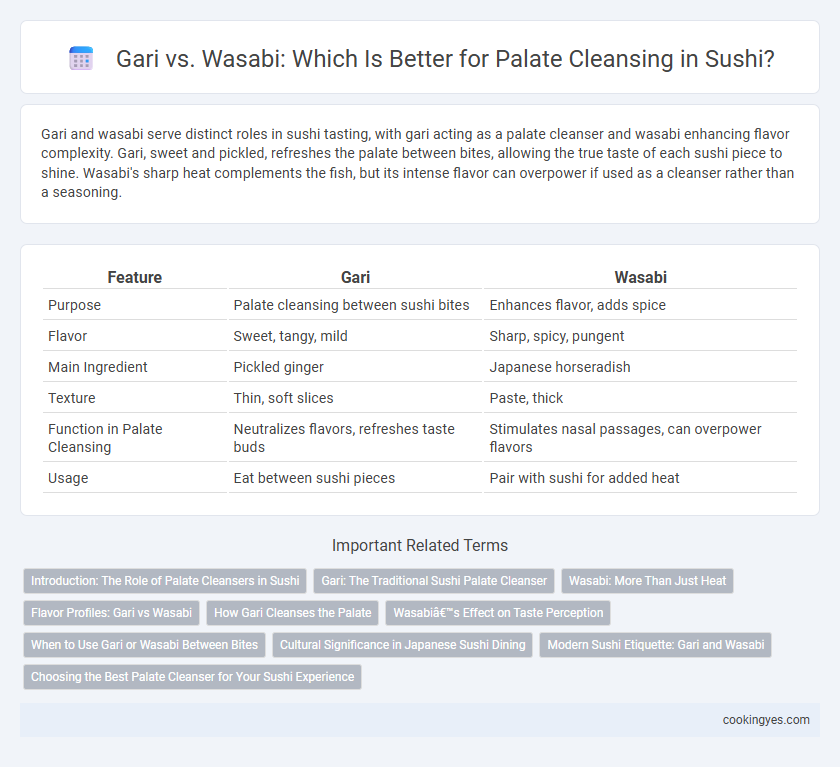Gari and wasabi serve distinct roles in sushi tasting, with gari acting as a palate cleanser and wasabi enhancing flavor complexity. Gari, sweet and pickled, refreshes the palate between bites, allowing the true taste of each sushi piece to shine. Wasabi's sharp heat complements the fish, but its intense flavor can overpower if used as a cleanser rather than a seasoning.
Table of Comparison
| Feature | Gari | Wasabi |
|---|---|---|
| Purpose | Palate cleansing between sushi bites | Enhances flavor, adds spice |
| Flavor | Sweet, tangy, mild | Sharp, spicy, pungent |
| Main Ingredient | Pickled ginger | Japanese horseradish |
| Texture | Thin, soft slices | Paste, thick |
| Function in Palate Cleansing | Neutralizes flavors, refreshes taste buds | Stimulates nasal passages, can overpower flavors |
| Usage | Eat between sushi pieces | Pair with sushi for added heat |
Introduction: The Role of Palate Cleansers in Sushi
Palate cleansers in sushi serve to refresh the taste buds, allowing each piece of sushi to be enjoyed with distinct flavors. Gari, pickled ginger, provides a sweet and tangy flavor that neutralizes residual tastes between bites. Wasabi adds a sharp, spicy intensity that clears the palate while complementing the sushi's umami profile.
Gari: The Traditional Sushi Palate Cleanser
Gari, thinly sliced pickled ginger, serves as the traditional palate cleanser in sushi dining, effectively refreshing the taste buds between different sushi pieces. Its mild sweetness and acidity help neutralize lingering flavors without overpowering the subtle nuances of delicate sushi fish. Unlike wasabi's sharp heat, gari's gentle zest enhances the overall sushi tasting experience by maintaining balance and cleanliness on the palate.
Wasabi: More Than Just Heat
Wasabi serves as more than just a fiery condiment; its complex flavor profile includes sharp, herbal, and slightly sweet notes that enhance the sushi experience while cleansing the palate. Unlike gari, which offers a sweet and tangy taste that refreshes the mouth between bites, wasabi's pungent compounds stimulate salivation and olfactory senses, preparing taste buds for subsequent flavors. This unique sensory impact makes wasabi an integral element in traditional sushi tasting, balancing and elevating the overall dining experience.
Flavor Profiles: Gari vs Wasabi
Gari, pickled ginger, offers a sweet and tangy flavor that refreshes the palate without overwhelming the delicate taste of sushi, while wasabi provides a sharp, spicy heat that enhances bold flavors but can overpower subtle textures. The ginger's mild acidity and crispness cleanse the mouth gently, contrasting with wasabi's intense wasabiol compound that stimulates the nasal passages and adds a pungent kick. Choosing between gari and wasabi depends on whether a subtle, aromatic reset or a vibrant, spicy sensation is preferred to complement sushi's flavor profile.
How Gari Cleanses the Palate
Gari, thinly sliced pickled ginger, effectively cleanses the palate by providing a sharp, sweet, and slightly tangy flavor that neutralizes lingering tastes between sushi bites. The natural acidity and mild spiciness of gari stimulate saliva production, enhancing the freshness of subsequent sushi pieces. Its antimicrobial properties also contribute to a refreshing sensory reset, ensuring each bite is savored with optimal flavor clarity.
Wasabi’s Effect on Taste Perception
Wasabi significantly enhances taste perception by stimulating the nasal passages and amplifying the flavors of sushi without overpowering the palate, unlike gari which primarily acts as a sweet and acidic palate cleanser. The pungent compounds in wasabi, such as allyl isothiocyanate, trigger a mild heat that sharpens the taste buds, heightening the sensitivity to umami in fish. This unique sensory effect makes wasabi a preferred choice for intensifying flavor profiles between sushi bites rather than simply neutralizing taste.
When to Use Gari or Wasabi Between Bites
Gari, the sweet and tangy pickled ginger, is best used between sushi bites to cleanse the palate and refresh taste buds, enhancing the flavors of each piece. Wasabi, with its sharp and pungent heat, is traditionally applied directly to sushi or mixed with soy sauce to complement the fish, not for palate cleansing. Using gari between bites resets flavor perception, while wasabi intensifies the immediate sushi experience.
Cultural Significance in Japanese Sushi Dining
Gari, thinly sliced pickled ginger, is traditionally used in Japanese sushi dining to cleanse the palate between different sushi pieces, allowing diners to fully appreciate the unique flavors of each type. Wasabi, a pungent green horseradish, serves primarily to enhance the sushi's flavor and provide a subtle spiciness, reflecting its historical role in Japanese cuisine as both a flavor enhancer and antimicrobial agent. The cultural significance of gari versus wasabi lies in their distinct functions: gari as a palate cleanser promoting savoring sushi's variety, and wasabi as a seasoning essential to the authentic taste experience.
Modern Sushi Etiquette: Gari and Wasabi
Gari, thinly sliced pickled ginger, serves as a refreshing palate cleanser between sushi pieces, enhancing the dining experience by neutralizing flavors. Wasabi, a pungent green paste, adds a spicy kick that complements sushi, but should be used sparingly to avoid overpowering delicate fish flavors. Modern sushi etiquette encourages using gari for cleansing the palate and wasabi to subtly enhance sushi, respecting the chef's intended balance of flavors.
Choosing the Best Palate Cleanser for Your Sushi Experience
Gari, the thinly sliced pickled ginger, offers a sweet and tangy flavor that effectively resets the palate without overpowering the delicate taste of sushi. Wasabi delivers a sharp, spicy heat that can intensify flavors but may overwhelm subtle sushi nuances if used excessively. Selecting between gari and wasabi depends on whether you prefer a mild, refreshing cleanse or a bold, pungent contrast to enhance your sushi experience.
Gari vs Wasabi for Palate Cleansing Infographic

 cookingyes.com
cookingyes.com